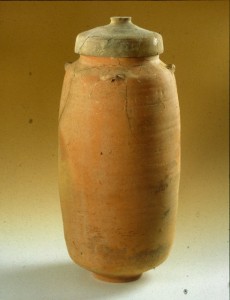Circulation, Gathering and Storage of the Dead Sea Scrolls
 Circulation
Circulation
It is clear that some texts were widely circulated. This is the only sensible way to understand how some apocryphal-pseudipigraphical books are found in various translations, while Hebrew and Aramaic originals are found at Qumran. Further, the Qumran collection has multiple copies of various books, both biblical and non-biblical, written often in different writing systems and clearly of disparate origin. Biblical manuscripts have been found at Qumran, Masada, and in the Bar Kokhba Caves dating over a few centuries. These chance examples of preservation probably indicate that biblical manuscripts were widely spread in the Land of Israel. Further, the presence of some of these same apocryphal and pseudpigraphic works at Qumran and Masada also indicates that these works were part of the literature of the wider Jewish community and constitute exactly the types of works prohibited by the tannaim as Sefarim ḥișoniyim, “external books,” that is, books outside the list of authoritative books.[1]
Gathering and Storage
One of the things that became clear with the study of the entire collection is that the scrolls found at Qumran in the eleven caves were of disparate origin geographically and in their literary traditions.[2] Only the sectarian Scrolls (about one-third) even related to the particular views of the Dead Sea sect.[3] Further, even if the contents are mostly uniform, the collection of Greek texts in Cave 7[4] indicates that even within the sect there were differences in holdings in the various caves.[5] Overall, the practice of gathering biblical and other books into a collection can be seen here.
We are accustomed to referring to the Qumran collection as a library. Some have tried to argue with this concept.[6] However, since the origins are disparate, as testified to also by the fact that only a few scribes appear more than once, the library theory is most likely. Further, we have evidence of the wearing out and repair of books, correction over a period of years, and the use of multiple copies that confirm the notion that this collection was made by the group that occupied the buildings at Qumran. This is especially true of the collection of Scrolls found in Cave 4 that in antiquity had shelves on which the manuscripts were stored, probably sideways. Further, the common conception that Scrolls were stored in jars needs to be corrected. Most Qumran Scrolls were not stored in jars. Some, however, were, and these often were wrapped in linen cloths. In general, Scrolls were tied closed with leather things that attached to the back of the scroll at its start with little squares of leather. While numerous jars were found with the Scrolls, no Scroll was ever found in a jar by an archaeologist. However, some written material was attached to a jar brought for sale by the Bedouin. From the excessive height of the “Scroll jars,” it is obvious that they were manufactured for food storage and only used secondarily, if at all, for scrolls.[7]
Thus far, we have been talking about a library of real books, but we need to remember that in some Second Temple texts, there also exists a “library” of pseudo-books or imaginary works. Here we refer to books that are totally imagined, functioning to convey ancient, often ante-diluvian traditions to the forefathers of Israel. Often this motif is employed to argue for the authenticity of pseudepigraphal works that claim to divulge the teachings of patriarchs and other biblical figures who are said to have received knowledge from these ancient books.[8] From the point of view of this study, the imagining of such books shows the extent to which written texts are assumed to be the authoritative conveyance of Jewish teachings.
[1] Schiffman, Reclaiming, 399-403.
[2] E. Tov, Hebrew Biblical Manuscripts from the Judaean Desert: Their Contribution to Textual Criticism,” JJS 39 (1988): 5-37.
[3] D. Dimant, “The Qumran Manuscripts: Contents and Significance,” in Time to Prepare the Way in the Wilderness: Papers on the Qumran Scrolls by Fellows of the Institute for Advanced Studies of the Hebrew University, Jerusalem, 1989-90 (ed. D. Dimant and L. H. Schiffman; STDJ 16; Leiden: E. J. Brill, 1995) 23-58.
[4] Tov, Scribal Practices, 301.
[5] S. J. Pfann, “Reassessing the Judean Desert Caves: Libraries, Archives, ‘Genizas’ and Hiding Places,” Bulletin of the Anglo-Israel Archaeological Society 25 (2007): 147-170.
[6] N. Golb,“The Dead Sea Scrolls: A New Perspective,”The American Scholar (1989): 177-207, idem, “Khirbet Qumran and the Manuscripts of the Judaean Wilderness: Observations on the Logic of Their Investigations,” JNES 49 (1990): 103-14; idem, “Who Wrote the Dead Sea Scrolls?” The Sciences (May/June 1987): 40-49; Y. Hirshfeld, “Qumran during the Second Temple Period: Re-evaluating the Archaeological Evidence [Hebrew],” Cathedra 109 (2004): 5-50.
[7] S. J. Pfann, “Kelei Dema’: Tithe Jars, Scroll Jars and Cookie Jars,” in Copper Scroll Studies (ed. G. J. Brooke and P. R. Davies; JSPSup 40; London: Sheffield Academic Press, 2002) 163-79.
[8] L. H. Schiffman, “Pseudepigrapha in the Pseudepigrapha: Mythical Books in Second Temple Literature,” Revue de Qumran 21/3 (2004): 429-438.

Leave a Reply